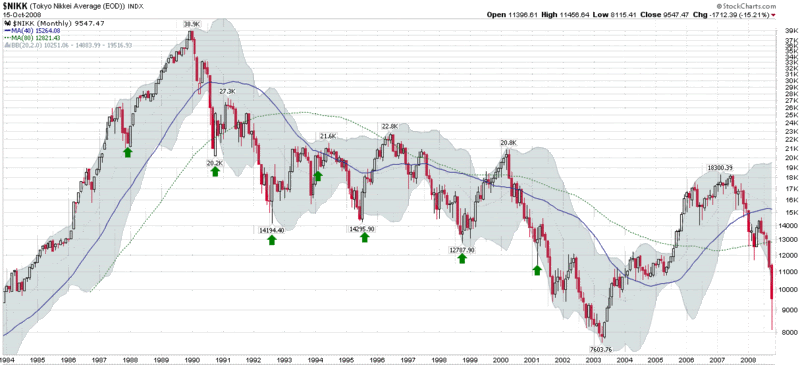Should You Go Long at Volatility Extremes? A Look at the Nikkei 225
Japan’s Nikkei 225 stock index is the primary index used to track the Tokyo Stock Exchange. It was also the index that captured the fall of the Japanese stock market from 38,959 on the last day of 1989 to 7,603 in April 2003, a drop of 81% over the course of more than 13 years.
The Nikkei, therefore, provides an opportunity to test the idea of whether it is profitable to initiate new long positions in times of extreme volatility, even in prolonged bear markets.
In order to test this hypothesis, I reviewed the data for the Nikkei 225 from 1984 to the present and singled out the ten most volatile days during this period, using various volatility measures such as historical volatility and average true range. The result, which includes a number of overlapping days and clusters of similar volatility extremes, is displayed graphically in the chart below, courtesy of Stockcharts.com. In the chart, the seven instances with the highest volatility levels are highlighted by green arrows. Note that in each case a rally of at least two months followed these volatility extremes. In the one bull market example, the new bullish trend lasted for two years; in all the other bear market examples, the new bullish trend lasted from two months to 1 ½ years.
For the record, the action in the last two weeks in the Nikkei would make the current environment the most volatile of all instances, just as is the case for the S&P 500 at the moment.
While all bear markets are not created equally, Japan's "lost decade" does bear some resemblance to the problems in the U.S. Looking at the historical record with a global perspective, it is tempting to conclude that the current situation ripe for another volatility bounce of at least two months.

[source: StockCharts]


6 comments:
Well yes, buying at the highest volatility points will generally work. The question is how do you know in real time what to do? How many times has VIX made a new high in the past month? Were any of those good buying opportunities for more than a day or two? At some point, there will be a bottom. At that time, volatility will probably be at a new high. But we don't know if that new high will be the VIX at 80, 90, 120, 150, or 200. When we look back 10 years from now it will be easy to identify the bottoms. Can you repeat this study without forward looking data? In other words, rather than looking at the highest volatility periods in the past ten years, look at the times that were volatility highs as viewed in real time. The results will be very different.
jkw
All good points, jkw, not the least of which is that it is easy to pick tops and bottoms with 20-20 hindsight.
I do have some methods (which I am not going to detail here) that can help identify market turning points with what I would consider a reasonable degree of accuracy.
Let me give some thought to how much I am going to share here, but I will eventually get around to answering your question more specifically.
Cheers and thanks for weighing in,
-Bill
Yeah I was going to say what jkw said. This morning was a good example. Perhaps the VIX has topped out at just under 100. Perhaps not. I am betting not.
Since this decade was so shitty to investors you think its setting the stage for the next decade to be an excellent buy and hold environment? hmmm...
Stockrake,
I think your alternating decades theory has merit. Brett Steenbarger at TraderFeed has posted a lot about rolling ten year returns, including his recent Negative Decades of Returns.
Cheers,
-Bill
This is where that old chart of value first, smart money second, speculators third, is going to happen. If not now, then soon. I'm not sure where I saw that, but its the 3 zones of a bull market.
Post a Comment